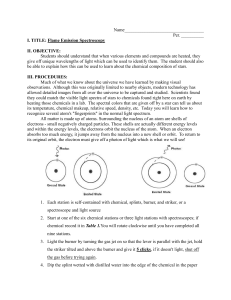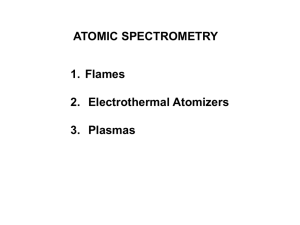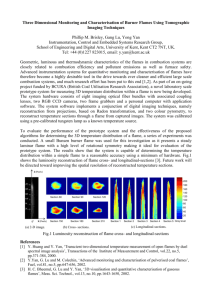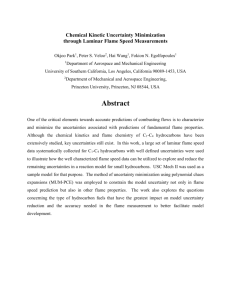Oscillating flames in a gas turbine burner with and without
advertisement
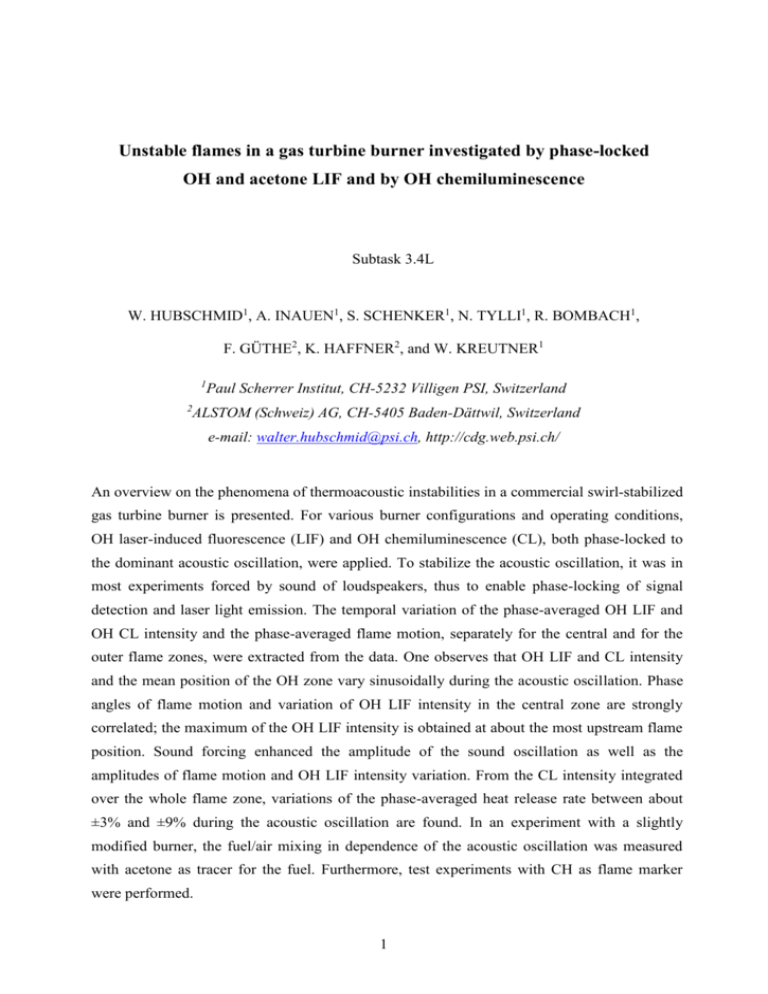
Unstable flames in a gas turbine burner investigated by phase-locked OH and acetone LIF and by OH chemiluminescence Subtask 3.4L W. HUBSCHMID1, A. INAUEN1, S. SCHENKER1, N. TYLLI1, R. BOMBACH1, F. GÜTHE2, K. HAFFNER2, and W. KREUTNER1 1 2 Paul Scherrer Institut, CH-5232 Villigen PSI, Switzerland ALSTOM (Schweiz) AG, CH-5405 Baden-Dättwil, Switzerland e-mail: walter.hubschmid@psi.ch, http://cdg.web.psi.ch/ An overview on the phenomena of thermoacoustic instabilities in a commercial swirl-stabilized gas turbine burner is presented. For various burner configurations and operating conditions, OH laser-induced fluorescence (LIF) and OH chemiluminescence (CL), both phase-locked to the dominant acoustic oscillation, were applied. To stabilize the acoustic oscillation, it was in most experiments forced by sound of loudspeakers, thus to enable phase-locking of signal detection and laser light emission. The temporal variation of the phase-averaged OH LIF and OH CL intensity and the phase-averaged flame motion, separately for the central and for the outer flame zones, were extracted from the data. One observes that OH LIF and CL intensity and the mean position of the OH zone vary sinusoidally during the acoustic oscillation. Phase angles of flame motion and variation of OH LIF intensity in the central zone are strongly correlated; the maximum of the OH LIF intensity is obtained at about the most upstream flame position. Sound forcing enhanced the amplitude of the sound oscillation as well as the amplitudes of flame motion and OH LIF intensity variation. From the CL intensity integrated over the whole flame zone, variations of the phase-averaged heat release rate between about ±3% and ±9% during the acoustic oscillation are found. In an experiment with a slightly modified burner, the fuel/air mixing in dependence of the acoustic oscillation was measured with acetone as tracer for the fuel. Furthermore, test experiments with CH as flame marker were performed. 1 1 INTRODUCTION Modern industrial gas turbines are operated at very lean premixed flame conditions in order to reduce the emission of NOx. Under these conditions they are prone to thermoacoustic instabilities that are detrimental to the lifetime and power generation capacity of the engine. The temporal variation of the heat release in flames is assumed to be the main cause for the generation of pressure waves in combustion. Due to acoustic resonance of the combustor and the feedback of the pressure variation on the fuel/air mixing and on other quantities like the turbulence intensity, there is a selective amplification of the acoustic noise. The final goal of a theoretical description of the observed phenomena is to predict growth conditions for pulsation modes and the asymptotic behaviour for the various modes of the pulsation spectrum. This, however, is not yet achieved by numerical simulations. Thus, to date, simulations alone can not yet give accurate criteria on how to minimize the pressure oscillations in gas turbine combustors. The present contribution focuses on phenomena related to thermoacoustic instabilities in single swirl-stabilized gas turbine burners. These phenomena were observed with the OH LIF technique and, for supplementary information, with the passive OH CL technique. Phaselocking to the dominant acoustic oscillation was systematically applied. This paper contains selected results of a systematic investigation of different burner configurations and operating conditions; the complete presentation is given in Ref. 1. The temporal variation of both the OH LIF and OH CL signal intensity and the flame motion are derived from the data averaged at various phases of the sound oscillation, and the relation between the phase-averaged OH LIF and the flame motion is discussed. By means of tracer LIF we determined the feedback of the dominant sound oscillation to the fuel/air mixing. The tracer, acetone, was added to the fuel, natural gas, prior to mixing. This individual experiment was performed in the mixing section of a burner specifically designed to provide optical access. The radical CH, which superiorly represents the local heat release, has a very low concentration at the air-equivalence ratios (λ > 2) of gas turbine combustion. To estimate the CH concentration at those -values, we applied the program PREMIX [2], which uses the GRI 3.0 reaction mechanism, to a 1-D freely propagating flame. For λ = 2, a preheat temperature of 673 K and p = 1 bar, a CH concentration of 0.07 ppm was obtained. In test experiments at a slightly modified gas turbine burner, exciting the B-X (1,0) transition of CH and detecting the B-X(1,1) and the A-X(0,0) bands, we found that spectrally on-resonance intensities in the flame zone were only about 5% stronger than the off-resonance intensities. We observed that the CH LIF intensity oscillates with the frequency of the sound oscillation 2 in a similar way as we discuss it in this paper for the OH LIF intensity. A further and more detailed interpretation of the results is difficult, however, and not pursued in the present paper. CH2O as indicator of heat release was not considered for this investigation. Further experiments will show the suitability of this heat release marker. We also plan to do phaseresolved measurements of the fuel concentration using NO as tracer species. 2 EXPERIMENTAL SET-UP The combustor investigated in the experiments is a commercial single swirl-stabilized gas turbine burner (in various types) of Alstom, as described in Ref. 3. Figure 1 shows a schematic drawing of the burner itself and the combustion chamber. The fuel/air supply, upstream of the burner, and the stainless steel exhaust are not shown. The fuel, natural gas, is injected along the air slots of the burner cone and from a lance situated in the cone axis. The preheated air (T > 400°C) enters from the plenum through the slots separating the two half-cones of the burner, which are slightly displaced in transverse direction with respect to each other. Fuel and air mix in the burner cone and enter the cylindrical combustion chamber with a high swirl. At the sudden expansion into the combustion chamber, recirculation zones are formed in the central and outer region. This is confirmed by numerical simulations [4] as well as by LDA measurements in water flows [5]. The position of the flame on the burner axis is close to the stagnation point of the central recirculation zone. Part of the combustion chamber, from the burner exit plane to approximately one chamber diameter length downstream, was made of UV transparent quartz glass. All measurements were performed at atmospheric pressure. In the majority of measurements, an orifice had to be inserted in the burner exhaust in order to reduce the sound level [3]. In these cases, the plenum air and/or the flue gases had to be seeded by sound of loudspeakers, operated at the frequency of the dominant acoustic oscillation, to achieve thermoacoustic instabilities continuous enough to allow for phase locking of the laser system. Two sets of four loudspeakers each were mounted at the fuel/air supply upstream of the burner and at the exhaust, respectively. Although the power of the eight loudspeakers (8 x 150 W) was low compared to the sound generated by the flame, the forcing was sufficient to provide for a sound level continuous enough for the phase-locked LIF measurements. The influence of the loudspeakers was determined by operating only the upstream loudspeakers (partial forcing) or both sets (full forcing). The sound pressure in the 3 combustion chamber was measured with a calibrated water-cooled microphone positioned close to the flame zone (about 1.5 chamber diameters downstream of the burner edge). The frequency doubled output of a pulsed Nd:YAG/dye laser system (Quantel YG781/TDL50) at 286 nm was used for excitation into the P1(7) line of the A←X (1←0) transition of the OH radicals. The repetition rate of the Nd:YAG laser was fixed to 20 ± 0.2 Hz, whereas the dominant frequency of the combustion instabilities was above 100 Hz. A specially designed phase-lock loop (PLL) filter allowed for locking of the laser repetition rate to the specific thermo-acoustic frequency. The period of the acoustic oscillation was divided into either 8 or 24 intervals, i.e. 45° or 15° phase resolution, respectively. Because of time delays in the electronics the laser pulses are retarded by about half a period with respect to the pressure phase at the microphone. This means that a phase angle of about 270° for the laser pulse corresponded to the maximum sound pressure. By appropriate combination of cylindrical and spherical lenses the laser beam was shaped into a slightly divergent light sheet, propagating from bottom to top of the combustion chamber tube. The direction of propagation defines the y-axis (see Fig. 1). The transverse extension of the sheet was parallel to the symmetry axis of the tube, i.e. the z-axis. Using an intensified CCD camera (LaVision FlameStar II) equipped with a band pass filter centered at 310 nm, the LIF signal was detected normal to the plane of the light sheet. The OH CL was recorded with the same phase delay as the OH LIF and the same camera position. Exposure time was 0.1 ms. The observation area in flow direction is larger for the CL technique, as compared to the LIF recordings, as it was not limited by the width of the laser sheet. The burner used for the main part of the experiments did not provide optical access to the fuel / air mixing section. For the investigation of the modulation of the fuel-air mixing by the sound wave, we used a specific version of the burner, which had an optically accessible fuel-air premixing section. The laser light sheet entered from below covering the whole transparent section length along the symmetry axis. The emitted light was detected at right angles. For visualization of the fuel/air mixing process we used acetone as a tracer. The tracer was added to the fuel, natural gas, prior to mixing. Typical tracer mole fractions were below 2%. Acetone was excited using the fourth harmonic of the Nd:YAG at 266 nm. The laser-induced fluorescence light was collected using the same camera as described above, this time equipped with a long pass filter (Schott WG295) to separate the signal from scattered laser light. 4 beam dump y burner laser light sheet quartz combustion chamber z flow direction microphone CD ra IC me ca beam shaping optics pulsed Nd:YAG/dye laser system Fig. 1: Schematic arrangement of the experimental setup. 3 SELECTED RESULTS 3.1Single-pulse and phase-averaged OH LIF We show in Fig. 2a examples of single-pulse OH LIF measurements at an arbitrarily chosen phase of the dominant acoustic oscillation. Figure 2b shows the corresponding average over 100 pulses. The single-pulse pictures show that the ignition, i.e. the onset of OH, from pulse to pulse is situated at very different locations ranging over a large interval in axial direction. Moreover, the shape of the flame varies strongly. No pattern obviously characteristic for this or any other phase angle can be recognised. Averages at fixed phases of the dominant acoustic oscillation show a more regular behaviour. In Fig. 3a) the phase-averaged OH LIF distribution at a specific configuration is depicted in phase steps of 45°. The cross-section of the OH zone with the laser light sheet is a v-shaped domain in the center, with an opening angle of about 40° with respect to the transverse plane. Additional OH zones are seen in the outer recirculation zones. The temporal behaviour of these phase-resolved, averaged OH distributions is most strikingly seen from a video. Both a periodic variation in OH LIF intensity and spatial motion of the OH zone can be recognised. Qualitatively, the OH LIF intensity oscillates stronger in the outer zones and oppositely to the one in the center, as can be recognized from the image series of Fig. 3a. 5 a) b) Fig. 2: a) Selection of single-pulse OH LIF intensity images in the combustor duct at the phase of 0° for the dominant acoustic oscillation. b) For comparison the corresponding phase-averaged measurement, i.e. averaged over 100 single pulses. Flow is from left to right. Fig. 3: a) Phase-averaged OH LIF intensity measurements for one period of the dominant acoustic oscillation at the phases of 0°, 45°, 90°, 135°, 180°, 225°, 270° and 315°; burner orientation 90°. b) Phase-averaged OH CL intensity measurements with same conditions as in a). c) ditto, with burner orientation 0°. The camera position was shifted downstream for b) and c) by about d/8 compared to a). Therefore figures b,c) have been shifted to the right with respect to a), so that corresponding points in the combustion chamber lie on the same vertical lines. 6 For a detailed analysis of the phase-averaged measurements, the 2-D distribution of the OH LIF (or OH CL) intensity is split into five zones: in a central zone, two peripheral zones close to the burner wall, named bottom and top zones ("bottom" and "top" refer to the set-up geometry), and two transition zones in between, as shown in Fig. 4a. A small part of the combustion chamber at the very bottom is masked by mechanical elements of the test rig. Tests with finer subdivision of the central zone showed identical behaviour of all subzones. The same applies for the top and bottom zones. The splitting of the images in five zones proved robust enough for all LIF series. The laser light sheet covered the main heat release zone and, thus, the main area of OH formation. In small concentration, however, OH is still found further downstream than the usual position of the light sheet. In order to provide a more complete picture, we show in Fig. 4b the LIF measurements combined from experimental data with light sheet close to the burner edge and from datas with light sheet shifted downstream by about the sheet diameter. top flame zone central flame zone bottom flame zone Fig. 4a: Spatial assignment of the OH LIF cross Fig. 4b: Phase-averaged OH LIF intensity section with the light sheet in the normal position. distribution, combined from measurements with light sheet at normal position and at position shifted downstream. For most experimental series for the different burner configurations a sine function can well be fitted to the phase averaged OH LIF intensity data, separately integrated spatially for central, bottom, and top zones. The phase angles of the maximum LIF intensity in the central zone are noted in Table 1. In a few cases, the correlation of the experimental values and the fitted sine function was bad, i.e. in the order of the sine amplitude. In this case, no value for the phase angle of the maximum intensity is noted in the table. Figures 5a and 5c show the phase-averaged OH LIF intensities, integrated over the central flame zone, as a function of the oscillation phase for a series without and with acoustic forcing, respectively. We observe a 7 variation in intensity of about ±6% and ±9%, respectively, during one oscillation period. In the transition zones the intensity variation is reduced and the phase is shifted somewhat, compared to the central zone, whereas in the bottom and top zones averaged LIF intensities vary stronger again. The relative statistical fluctuations of the single-pulse LIF intensities for the central flame zone at a given phase are of the order of 30% (standard deviation divided by mean intensity). A detailed analysis gave relative fluctuations of 26…34% and 26…32% for the various phase angles of two selected measurement series. Therefore, standard deviations of the mean values are about 3% for N = 100 pulses. This agrees approximately with the deviations of the mean values of the various phases from the fit curve, see Fig. 5c. 3.2 Phase-averaged OH chemiluminescence Figures 3b and c show the phase-resolved OH CL measurements of two experimental series, which differed in the circumferential orientation of the burner only. The phase-averaged 2-D OH CL signals were integrated a) over the whole flame zone, and b) over the bottom zone alone. The bottom zone was defined in the same way as for LIF, see Fig. 4. Distinctly observable is a general asymmetry of the intensity distribution, i.e. higher CL intensity in the upper part of the figure. The entire CL intensity obtained from a) represents an approximate measure (see below) for the mean total heat release rate at a specific phase angle. The CL intensity obtained from b) has only contributions from the outer flame zone, in contrast to CL signals in the center of the image where all the flame zones contribute due to the line-of-sight character of CL. The total CL intensity varied in good accuracy sinusoidally during the period of a sound oscillation. Additional not phase-resolved experiments, at one specific operation condition and burner configuration and with variation of the global λ (i.e. the total heat release rate) only, showed that the OH CL intensity reacts very sensitively on the variation of λ: We find that CL intensity variations are stronger by a factor 4 than the variations of λ. Heat release rate variations are assumed to be caused at least partly by the sound modulation of the global λ. Taking into account the factor 4 for the total of the heat release rate variation, we find that it is in the range between ±3% and ±9%, depending on the experimental conditions. According to the plane wave solution of Eq. 1, during the observed quasi-steady flame oscillation, sound waves with pressure amplitudes between about 0.8×102 and 2×102 Pa are generated in the flame zone by these variations of the heat release rate. They are superposed to the sound waves formed previously and being reflected back and forth in the combustion chamber. 8 Figure 6a shows the phase dependence of the total CL intensity for a selected series. The CL intensity variations for the bottom zone alone are similar in amplitude and phase angle to the total flame zone variations (see Fig. 6b), and also, as an additional analysis showed, similar to the variations in the top zone. 3.3 Phase-averaged motion of the flame As the flame in the gas turbine burner is rather spread out, various quantities can be defined to represent its position and motion. For the analysis given in this paper, the absolute value of the flame position is of minor importance; rather a relative value with an arbitrary offset is required. The flame position can be defined both from OH LIF and OH CL data. In a first definition, the flame position is identified with the phase-averaged center of the OH LIF intensity in axial direction, here called center of mass (CM). This quantity is averaged along the radial coordinate y, i.e. along the light sheet propagation, separately for the central zone as well as for the bottom and top zone of the combustion chamber. For most experimental series, a sine function can well be fitted to the phase-averaged OH LIF intensity data, separately spatially integrated for the central, bottom and top zone. The phase angles of the minimum (i.e. most upstream) flame position for the central zone are summarized in Table 1. As examples, Figs. 5b and 5d show the evolution of CM in the central zone as a function of the oscillation phase for the same series as was shown the OH LIF intensity in Sec. 3.1. The total variations of the CM flame position scaled by the chamber diameter, z fl / d , are 0.9·10-2 and 1.5·10-2, respectively. 3.4 Flame motion vs. OH LIF and OH CL intensity variation We observe that phase angles of maximum OH LIF intensity (as an approximate measure for the heat release rate) and of minimum flame position in the central zone are close to each other. Such a correlation reflects the general fact that the heat release rate is proportional to the burning velocity vb and the fuel concentration cfuel in the flame, under the additional condition that vb itself depends on cfuel. For a more quantitative analysis of the data, one has to relate the flame velocity as observed in the laboratory frame, to the flame velocity relative to the gas flow. Hereto, the acoustically undisturbed flow field in the combustor and the acoustic velocity in the gas have to be known. The procedure for such a reduction is given in the appendix. In case of a spatially inhomogeneous flow with a large negative gradient of the mean flow velocity, and when 9 neglecting the acoustic oscillation, one finds that the phase of the maximum flame velocity relative to the gas is at about the minimum flame position, whereas in case of a homogeneous flow field this maximum is at the backward (with respect to the flow) zero passage of the flame motion. For the flow conditions of the experiments the flame velocity in the central zone peaks at a phase angle approximately 30° lower than the phase angle of the minimum flame position. In this result the influence of the acoustic motion is neglected. Fig. 5: a) Variation of the OH LIF intensity in the Fig. 6: a) Variation of the OH CL intensity central zone during an oscillation period and integrated over the whole flame during an corresponding sinusoidal fit (—) for a series oscillation period and corresponding sinusoidal fit without acoustic forcing. b) Position zfl of the (—). b) Variation of the OH CL intensity in the center of mass for the OH LIF intensity in the bottom zone during an oscillation period and central zone during an oscillation period and corresponding sinusoidal fit (—). c) Position zfl of corresponding sinusoidal fit (—) for the same the center of mass for the OH CL intensity in the series. c, d) Respective quantities for a series bottom zone during an oscillation period and with acoustic forcing (identical with series of corresponding sinusoidal fit (—). Fig. 3a). 10 In the experiments the phase difference between maximum of heat release rate and minimum flame position in the central zone is between -52° and +25°, being thus close to the above mentioned value of -30°. Reasons for the difference and for the dispersion of the experimental data are various: neglect of difference of phase angles for the oscillations of cfuel and vb, of acoustic motion, and of difference between flame velocity and burning velocity; furthermore, inhomogeneity of average flow in the central zone, inaccuracy of the determination of phase angles (about 10 to 15°), and difference of phase angles of heat release rate and of variation of OH LIF intensity. A phase shift for the latter quantity arises, as was observed in Ref. 6, comparing the phases of OH LIF with CH2O LIF, CH LIF, or OH CL (as presumed indicators of instantaneous heat release). If one assumes in a model calculation that previously formed OH decays exponentially, one finds that the phase shift between variation of heat release rate and of OH concentration lies between 0 and 90°. The shift depends on the ratio of the decay constant to the angular frequency ω; it is reduced if the OH is transported out of the observation volume, as is the case for OH in the central zone. 3.5 Fuel concentration measurements with acetone as tracer Paschereit et al. [3] conjecture that the fuel concentration c fuel at the fuel injection is modulated by the sound wave. To get an experimental indication for this prediction, we performed a tracer LIF experiment with acetone, using a slightly different burner with optical access to the fuel / air mixing section. We found, at a specific operating condition, that the (electronically) phase-averaged LIF intensity varied by about ±6% during the period of the sound oscillation, see Fig. 7. The temporal variation of c fuel reaches with some time delay the flame zone and causes there a periodic variation of the heat release rate, and thus a coupling of the sound wave back to the flame. Fig. 7: Phase-averaged fuel concentration measurement with acetone as tracer. 11 4 SUMMARY We showed in this paper how 2-D OH LIF and CL techniques can be applied for the investigation of thermo-acoustic phenomena in gas turbine burners. Of main interests are the flame motion and the variation of the heat release, which is approximately determined from the variation of the OH LIF and OH CL intensity. To determine these quantities signal intensities were phase-averaged with respect to the dominant acoustic oscillation. In the majority of measurements, an orifice had to be inserted in the burner exhaust in order to reduce the sound level. In these cases, the plenum air and/or the flue gases had to be seeded by sound of loudspeakers to achieve thermoacoustic instabilities continuous enough to allow for phase locking of the laser system. A number of burner configurations and operating condition were studied and compared with each other. In part quantities were determined separately for the outer and the central flame zones. So far, some of the results are still of a semi-quantitative nature. Besides results, which are difficult to be interpreted straightforwardly, many regularities have been observed. To summarize, we found: – Phase-averaged OH LIF intensity and flame position of the various flame zones vary with good accuracy sinusoidally for most of the studied conditions. Oscillations are observed in the case of external sound forcing as well as without sound forcing. – Phase-averaged CL intensities integrated over the whole flame region vary in the range between ±13% and ±35% around their mean values for the various experimental conditions. At a specific operation condition total CL intensity variations were enhanced by the factor 4, compared with the variation of the global air-fuel ratio Considering this factor to determine the variation of the heat release rate, we obtain variations in the range between ±3% and ±9% during the acoustic oscillation for the spatially integrated phaseaveraged heat release rate. – Amplitudes of flame motion, and therefore experimentally observed variations of the flame propagation velocity, depend strongly on the chosen definition (center of mass or other) for the flame position. Phase angles of the flame motion, however, are much less sensitive to the choice of definition. – Phase angles of flame motion and OH LIF intensity variation varied for repeated measurements with identical conditions by ≤15°, while amplitudes of flame motion and peak sound pressures varied in the order of 10%. 12 – Sound pressures are strongly increased with sound forcing; it effects also a narrowing of the peak width in the sound frequency spectrum. Sound forcing enhances the amplitudes of the flame motion and the OH LIF intensity variation. – The outer flame zones reveal a deviation from axial-symmetry, which is clearly demonstrated by rotating the burner by 90° with respect to the laser sheet. – Phase angles of flame motion and of OH LIF intensity variation in the central zone correlate with each other. Observed differences of the phase angles are between -52° and +25°. The correlation is interpreted to be a consequence of the proportionality between heat release rate and burning velocity. – The fuel concentration cfuel is modulated by the sound wave. This is observed by phaselocked measurements of cfuel in the mixing part of the burner, using acetone as tracer. Acknowledgements Financial support by the Federal Office of Energy (BFE), by KTI (Kommission für Technologie und Innovation), and by ALSTOM (Schweiz) AG is gratefully acknowledged. References [1] Hubschmid W., Inauen A., Schenker S., Tylli N., Bombach R., Güthe F., Haffner K., Kreutner W., Oscillating flames in a gas turbine burner with and without acoustic forcing observed by phase-locked OH laser-induced fluorescence and chemiluminescence, submitted to Combust. and Flame. [2] Kee R.J., Grcar J.F., Smooke M.D., Miller J.A., A fortran program for modelling steady one-dimensional premixed flames, Tech. Rep. SAND85-8420, Sandia National Laboratories. [3] Paschereit C.O., Flohr P., Schuermans B., Prediction of combustion oscillations in gas turbine combustors, Paper AIAA 2001-0484, presented at the 39nd AIAA Aerospace Sciences Meeting, January 2001. [4] Flohr P., Schmitt P., Paschereit C.O., Mixing field analysis of a gas turbine burner, Proc. IMECE'02 (Paper IMECE2002-34317). [5] Paschereit C.O., Gutmark E., Weisenstein W., Coherent structures in swirling flows and their role in acoustic combustion control, Physics of Fluids 11:2667 (1999). 13 [6] Giezendanner R., Keck O., Weigand P., Meier W., Meier U., Stricker W., Aigner M., Periodic combustion instabilities in a swirl burner studied by phase-locked planar laserinduced fluorescence, Combust. Sci. and Tech. 175:721 (2003). 14

